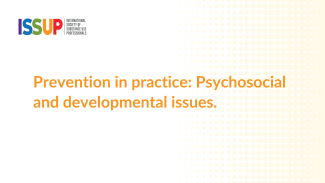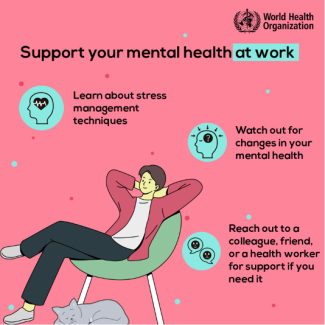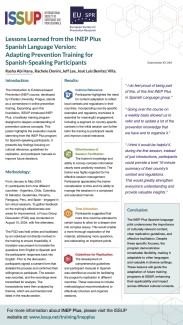Search
Text Messages Conveying Parental Drinking Limits: A Potential Avenue for Preventing and Reducing Alcohol Use in College Students
Previous studies have shown that when students perceive their parents set strict limits on underage drinking, they tend to consume less alcohol. However, the best ways to communicate these limits effectively remain unclear. To explore this...
Youth Voices in SUD Management: Challenges and Opportunities
Reflections on Mental Health Day 2024
Strengthening Substance Use Prevention in Tanzania through Evidence-Based Interventions
Prevención a través de medios de comunicación social
An Integrated Analysis of the Impact of Spanish Family Support Programmes with Informed Evidence
This article describes the quality of Spanish family support programs, focusing on their impact, community reach, expansion, and sustainability. EurofamNet selected 57 programs that had evidence-based results. Family support programmes...
ISSUP POSTER FOR EUSPR 2024: Lessons Learned from the INEP Plus Spanish Language Version: Adapting Prevention Training for Spanish-Speaking Participants
From September 11th to 13th, 2024, the International Society of Substance Use Professionals (ISSUP) participated in the European Society for Prevention Research (EUSPR) Conference held in Cremona, Italy.
The poster titled “Facilitators...
Journal of Prevention Science Early Career Reviewer Program: Request for Applications
Due Date: October 1, 2024
Overview:
The Prevention Science Early Career Reviewer Program aims to both mentor early career researchers in prevention science and increase the pool of possible reviewers. We invite emerging prevention...
Submit Your Plenary Session Proposal for the 2025 NIDA International Forum
Submit Your Plenary Session Proposal for the 2025 NIDA International Forum in New Orleans, Louisiana
Deadline: October 31, 2024
Save the date! The 2025 NIDA International Forum will take place as an in-person meeting in New Orleans...
SPR 2025 Call for Submissions Now Open!
SPR 2025 Call for Submissions Now Open! The Society for Prevention Research (SPR) is now accepting submissions for the 2025 Annual Meeting, which will be held May 27–30, 2025, in Seattle, WA.
Full details here: https://spr.confex.com/spr...
Estrategias de prevención laboral y el marco legal, basado en una experiencia chilena
Impacto de la Desinformación y la Información Errónea sobre Drogas en Niños y Adolescentes.
Day 3, 14:00 - 15:30, ICUDDR, Global Approaches in Substance Use Prevention , Treatment and Recovery: Insights from Vietnam, East Africa and the Madives
Presented at Thessaloniki 2024, on the 28th of June, 2024.
Moderator: Dr. Rehana Kader (⚑ South Africa) - SA ICUDDR
Presentations:
Duc Nguyen - Evolution of Vietnam's Strategies in Drug Prevention, Treatment, and Recovery: A Two-Decade...
Day 3, 11:00 - 12.30, ISSUP, Healing Pathways: Exploring Treatment Approaches in Substance Use Disorder
Presented at Thessaloniki 2024, on the 28th of June, 2024.
Moderator: Goodman Sibeko (⚑ South Africa) - ISSUP
Presentations:
Olga Katsiokali - Receptive group music therapy “Guided Imagery and Music” in the Therapeutic Community KETHEA...
Epidemic consumption in childhood: Psychoactive substances, Gambling and new technologies
Presented at Thessaloniki 2024 - Panel "Healing Pathways: Exploring Treatment Approaches in Substance Use Disorder", on the 28th of June, 2024.
Authors
Dr. MARÍA VERONICA BRASESCO (⚑ Argentina) 1
1. Universidad del Museo Social...
Day 2, 16:00 - 15:30, ICUDDR, Advancing Global Prevention Initiatives Standardization, Innovation & Cultural Adaptation
Presented at Thessaloniki 2024, on the 27th of June, 2024.
Moderator: Dr. Irina Pinchuk (⚑ Ukraine) - Ukraine ITTC Taras Shevchenko University
Presentations:
Renata Habinakova - Interactive platform for mental health support and...
Day 2, 14:00 - 15:30, ISSUP, Youth in Prevention
Presented at Thessaloniki 2024, on the 27th of June, 2024.
Moderator: Ms. Isabella Araujo (⚑ United States) - OAS/CICAD
Presentations:
Isabella Araujo - Engaging Youth in Substance Use Prevention
Novia Carter & Drusilla Blinker - Bridg...
Day 2, 16:00 - 15:30, ISSUP, Community Collaboration for Prevention
Presented at Thessaloniki 2024, on the 27th of June, 2024.
Moderator: Thomas Legl (⚑ Austria) - President of Euro TC
Presentations:
Stavroula Mastorodimou - Learning environments and conflict management: an ecological approach in...
Day 1, 14:00 - 15:30, ISSUP, Navigating Prevention: Insights from Diverse Programs and Strategies
Presented at Thessaloniki 2024, on the 26th of June, 2024.
Moderator: Ms. Sue Thau (⚑ United States) - CADCA - ISSUP Board Member
Presentations:
Robert Balster, Hala Najm and Olajumoke Koyejo - The Hubert H. Humphrey Fellowship Program...





